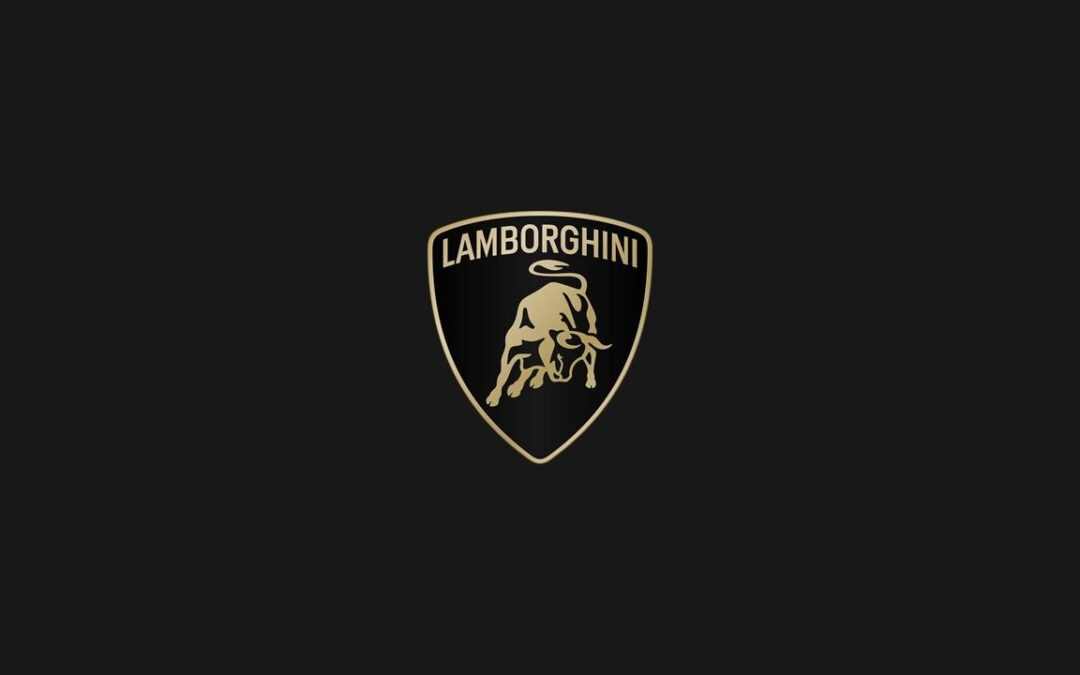All future cars produced by Sant’Agata will bear the new badge in the first brand identity update in more than twenty years.
Lamborghini announced today that they’ve joined the minimalist bandwagon with a new logo and typeface that will be found on all new models after the conclusion of Huracán production.
It comes as Lamborghini shifts to an all-hybrid model lineup, with an upcoming limited-edition Huracán expected to be the last fully gasoline-powered offering. Now, Lamborghinis desire to trend-follow has reached their famous golden bull logo, which now is a little less gold.
There’s been a spate of minimilast redesigns at car companies in recent years, including Kia, VW, Nissan, Buick, BMW, and many others. For most, the updated design is nothing more than a removal of metallic effects, flattening of the geometry, and sometimes a simplification of color pallete. See VW’s recent update, where the designers removed the three-dimensionality of the previous logo, deleted the blue background, and retained a simple two-dimensional frame of the logo.
Lamborghini have resisted a total neutering of their badge but have still removed most sense of three-dimensionality from it, and dullened the gold accents. Mercifully, the new badge retains the same bull outline and the same metallic sheen as before. Lamborghini have also introduced a new typeface for the badge, though you’d need a keen eye to spot the difference.
The famous bull itself has been released from its pen, as it were, as the company say the bull icon by itself will now be used separately from the badge, though apparently only in digital settings.
The rest of Lamborghini’s release speaks a lot about “changing contexts”, a “holistic shift”, and “[a] new trajectory focused on sustainability and decarbonization,” which may well be some of the least-Lamborghini-sounding phrases possible. The company clearly want to leave behind their dinosaurish, gas-guzzling image, and apparently this new logo is a step in that direction.
Commentary
Pretty much every minimalist car badge redesign has been terrible. Kia, for example, now appears to be ‘KN’ on every single new car they sell. But even if legibility remains, these new logos serve only to homogenize car brands and to reduce their individual identities in service only, it seems, of looking good in digital thumbnails on phone screens.
For the most part, Lamborghini has avoided sterilizing its own identity quite so badly as companies like Cadillac and Audi. But a slightly flatter, duller, new badge combined with Lamborghinis gung-ho approach to electrification makes for a worrying trend. Cars in general are getting more and more boring, more and more sterile and corporate, even as performance figures skyrocket with electrical assistance. In many cases, we are approaching cars-as-a-subscription-service territory, which would complete the downfall of cars from an extention of a driver’s personality to just another disposable appliance, much like the inkjet printer in your office that either does not work now or will not work in the near future. Brands like Lamborghini (see also the departed Saab and previous iterations of most French manufacturers, for example) are supposed to help insulate against that sort of trend.
And of course, there’s no indication that Lamborghini’s embrace of hybrid tech will be in service of anything as dystopian as that situation. You’d hope that Lamborghini have chosen hybrids only because of their performance potential. But as quoted in this article, some of Lamborghini’s official language points to a much more logical, adult sensibility than that for which they have previously been known. It’s great to put out yet another 1000hp hypercar that’s also environmentally responsible, but I’d contend few if any of the current generation of hybrid powerhouses inspire anything like the passion kids of the 1970s experienced looking at their poster of a Countach. There is a point where extreme performance becomes so overwhelming that it severs all connection between the driver and the car. Even the greatest hybrid hypercars yet produced lack sexiness; a function of less intoxicating engine sound, higher weight, and arcade-like performance characteristics. The immediacy of electric acceleration is impressive but lacks theater. Movement without any perceptible effort is just a physics problem and not a driving experience, which is why thrashing a Miata from 0-60 is more gratifying than it would be in a Tesla. Try driving the LaFerrari in Gran Turismo 7 or any other racing game and see what I mean. Then try a Lamborghini Gallardo, Murcielago, Aventador, or even the current Huracán and see which cars are more inspiring, which make you smile more.
The concern, then, is that Lamborghini’s priorities may be slightly out of wack. Smiles, both on the faces of owners but also from kids who get a glimpse of one on the city streets or who get to drive one on the Playstation, ought to be the mission. Profit too, I suppose. But environmental conscientiousness doesn’t really mesh with Lamborghini’s past identity. More importantly, and given the company’s low volume of sales, it isn’t even their responsibility. Maybe it’s all in the pursuit of better 0-60s, but personally I am so over performance figures as an indication of the value of a sports or supercar. The identity of Lamborghini and how that’s expressed in each car is much more the point.
It’s just a logo, I tell myself.
